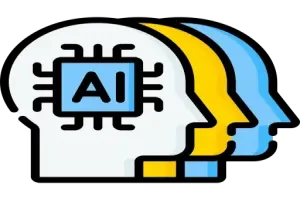
AI agents are revolutionizing the way humans tackle complex challenges, facilitating smarter decision-making and flexible task execution that goes beyond traditional AI systems like chatbots. Unlike chatbots, which rely on predetermined scripts, AI agents function independently, learning from data and adjusting their strategies in real time. This transition from fixed interactions to adaptive, context-aware systems enables them to grasp intent, forecast outcomes, and enhance decisions with minimal human involvement.
As AI agents continue to evolve, they are set to redefine industries such as healthcare, finance, and logistics by streamlining intricate workflows, boosting accuracy, and expanding decision-making capabilities.
In this article, we will delve into the architecture, applications, and future prospects of AI agents, emphasizing their role in reshaping modern problem-solving approaches.
Core Components of an AI Agent
AI agents consist of several essential components that enable their autonomy and adaptability:
- Tools: AI agents interact with external systems via APIs, databases, and various software tools. This capability allows them to access real-time data, perform calculations, generate reports, and execute actions beyond their basic functions.
- Memory: Memory is crucial for agents to retain information across sessions and tasks. Short-term memory ensures consistency within a single operation, while persistent memory supports long-term learning and context retention, such as remembering user preferences or details from past projects.
- Continual Learning: Unlike static systems, AI agents enhance their performance over time by incorporating feedback and analyzing prior results. This iterative learning process enables them to refine their strategies, adapt to new challenges, and improve their effectiveness with repeated use.
- Orchestration: AI agents can coordinate various components or collaborate with other agents. This involves breaking down complex objectives into manageable tasks and ensuring seamless execution, whether sequentially or in parallel.
By integrating these components, AI agents offer a level of autonomy and adaptability that surpasses traditional automation and chatbots.
How Do AI Agents Work?
AI agents function through a cycle of perception, reasoning, planning, and action, allowing them to execute complex tasks with a degree of autonomy and adaptability. While they don't think or plan like humans, they intelligently analyze inputs, determine optimal actions, and execute multi-step workflows.
Perception and Input Handling
AI agents begin by receiving inputs from their environment, which may include user commands, external databases, APIs, or real-time data streams. This input provides essential context for tasks, whether summarizing a document, retrieving specific data, or generating actionable insights.
Beyond simple input processing, AI agents engage in intelligent planning. They decide which tools to use, what memory to access, and the sequence of actions needed to achieve their goals. For instance, if a manager asks, “What is the stock of a certain item at all our stores?” the agent would:
- Retrieve a list of stores from memory.
- Query an external tool or API for stock levels.
- Aggregate the data into a structured response.
This ability to break down and orchestrate tasks highlights the agent's autonomy and planning capabilities.
Reasoning Through Models
After processing input, the agent employs advanced language models to reason through the task. These models enable the agent to extract information, identify patterns, and generate a plan of action. The reasoning process is guided by predefined prompts or logic, allowing the agent to make contextually appropriate decisions, even though it may not be as flexible as human reasoning.
Tool Usage
A defining characteristic of AI agents is their integration with external tools and systems. They can query APIs, interact with databases, generate reports, and perform calculations that extend beyond their inherent capabilities. For example, in inventory management, the agent doesn't inherently know stock levels but can dynamically query the relevant tools to obtain the necessary information.
Memory for Context and Improvement
Memory is crucial in how AI agents operate:
- Short-term Memory: Retains context during a single session or task, ensuring coherent interactions. This may include the agent’s chain of thought and intermediate data retrieved from tools or provided by users.
- Long-term Memory: Allows agents to store and recall information across tasks, such as user preferences, historical data, or organizational knowledge. This functionality is vital for maintaining consistency and building on prior actions. For instance, an AI agent assisting a research team might recall past queries to refine future searches, enhancing efficiency and personalization over time.
Planning and Task Execution
AI agents leverage orchestration models to break high-level tasks into structured plans. These models:
- Generate step-by-step workflows.
- Direct external tool usage.
- Adjust actions based on intermediate results.
By utilizing feedback loops, agents dynamically refine execution, optimizing efficiency and adaptability.
Continual Learning and Feedback
AI agents enhance their performance over time by incorporating user feedback and analyzing their outputs. When flagged for inaccuracies or incomplete responses, they can adjust their strategies to minimize future errors. For example, if an AI agent’s financial forecast is inaccurate, it can modify weighting factors or consult additional data sources for future predictions. This self-correcting ability adds significant value in dynamic environments where requirements evolve.
Collaboration and Orchestration
In more advanced scenarios, AI agents collaborate with other agents or humans to achieve broader goals. Through orchestration, they can coordinate tasks across multiple systems, managing dependencies and ensuring seamless execution. This capability is particularly beneficial in multi-agent environments where tasks must be distributed and completed either in parallel or sequentially.
While AI agents are not fully autonomous in the human sense, their ability to perceive, reason, plan, and intelligently execute tasks allows them to manage complex workflows efficiently. By integrating tools, leveraging memory, and improving through feedback, they provide dynamic, adaptable solutions across various applications.
- Log in to post comments